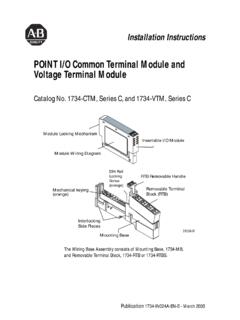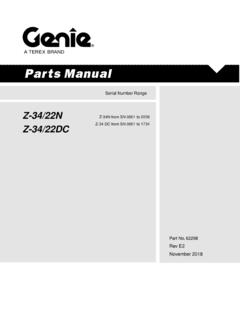Transcription of 1734-UM004F-EN-E POINT I/O Thermocouple and …
1 POINT I/O Thermocouple and RTD ModulesCatalog Numbers 1734-IR2, 1734-IR2E and 1734-IT2 IUser ManualPublication 1734-UM004F-EN-E - December 20122 Important User InformationSolid state equipment has operational characteristics differing from those of electromechanical equipment. Safety Guidelines for the Application, Installation and Maintenance of Solid State Controls (publication available from your local Rockwell Automation sales office or online at ) describes some important differences between solid state equipment and hard-wired electromechanical devices. Because of this difference, and also because of the wide variety of uses for solid state equipment, all persons responsible for applying this equipment must satisfy themselves that each intended application of this equipment is no event will Rockwell Automation, Inc. be responsible or liable for indirect or consequential damages resulting from the use or application of this examples and diagrams in this manual are included solely for illustrative purposes.
2 Because of the many variables and requirements associated with any particular installation, Rockwell Automation, Inc. cannot assume responsibility or liability for actual use based on the examples and patent liability is assumed by Rockwell Automation, Inc. with respect to use of information, circuits, equipment, or software described in this of the contents of this manual, in whole or in part, without written permission of Rockwell Automation, Inc., is this manual, when necessary, we use notes to make you aware of safety , Rockwell Automation, POINT I/O, RSLinx, RSLogix 5000, and TechConnect are trademarks of Rockwell Automation, not belonging to Rockwell Automation are property of their respective information about practices or circumstances that can cause an explosion in a hazardous environment, which may lead to personal injury or death, property damage, or economic information that is critical for successful application and understanding of the information about practices or circumstances that can lead to: personal injury or death, property damage, or economic loss.
3 Attentions help you identify a hazard, avoid a hazard, and recognize the HAZARDL abels may be on or inside the equipment, such as a drive or motor, to alert people that dangerous voltage may be HAZARDL abels may be on or inside the equipment, such as a drive or motor, to alert people that surfaces may reach dangerous 1734-UM004F-EN-E - December 2012 Table of ContentsImportant User Information .. 2 Summary of ChangesNew and Revised Information .. 7 Change Bars .. 7 PrefaceWho Should Use this Manual .. 9 Purpose of this Manual .. 9 Related Documentation.. 9 Common Techniques Used in this Manual.. 10 Chapter 1 About POINT I/O ModulesOverview.. 11 Module Features .. 11 Selecting a Module Input Type .. 12 Communicating with Your Module.. 12 Default Data Map for the Thermocouple Input Module(catalog number 1734-IT2I) .. 13 Default Data Map for the RTD Input Module(catalog numbers 1734-IR2, and 1734-IR2E).. 13 Data Format (1734-IT2I, 1734-IR2, and 1734-IR2E modules).
4 14 Use Module Alarms .. 15 Overrange Alarm (1734-IT2I, 1734-IR2, and 1734-IR2E modules) .. 15 Underrange Alarm (1734-IT2I, 1734-IR2, and 1734-IR2E modules) .. 15 Level Alarms (1734-IT2I, 1734-IR2, and 1734-IR2E modules) .. 15 Open-wire Alarm (1734-IT2I, 1734-IR2, and 1734-IR2E modules) .. 16 Cold Junction Compensation (1734-IT2I module) .. 16 Chapter Summary.. 16 Chapter 2 Install the ModuleOverview.. 17 Preventing Electrostatic Discharge .. 17 Environment and Enclosure .. 18 Install the Mounting Base .. 18 Install an I/O Module .. 20 Install the Removable Terminal Block .. 21 Remove a Mounting Base .. 22 Wire the Modules .. 23 Chapter Summary.. 24 Chapter 3 Configure Your ModuleOverview.. 25 Configuration Overview .. 25 Commissioning a Node .. 25 Publication 1734-UM004F-EN-E - December 2012iv Table of ContentsUsing the RSNetWorx Commissioning Tool.. 26 Use Sequential Auto Addressing.. 27 Use Third Party Configuration Software.
5 27 Add the Adapter to Your Network.. 27 Add I/O Modules to Your Network POINTBus .. 28 Set the Thermocouple Input Module Parameters Using RSNetWorx 30 Configure Your Thermocouple Input Module.. 32 Basic Set-up Parameters .. 32 Advanced Setup Parameters .. 33 Basic Setup .. 35 Advanced Setup .. 36 Set the RTD Input Module Parameters Using RSNetWorx .. 37 Configure Your RTD Input Module .. 39 Basic Setup Parameters .. 39 Advanced Setup Parameters .. 40 Basic Setup .. 42 Advanced Setup .. 43 Check I/O Status and View the EDS File .. 441734-IT2I module .. 441734-IR2 and 1734-IR2E modules .. 45 Chapter Summary .. 46 Chapter 4 Calibrate Your ModuleOverview .. 47 When and How to Calibrate Your Module .. 47 Calibration Method .. 47 Tools and Equipment Required to Calibrate Your Thermocouple Module.. 47 Calibrate the Thermocouple Input Module .. 48 Access Calibration Parameters in RSNetWorx .. 49 Input (mV) Calibration.
6 50 Cold Junction Compensation Calibration .. 53 Tools and Equipment Required to CalibrateYour RTD Module .. 56 Calibrate the RTD Input Module .. 56 Chapter Summary .. 60 Chapter 5 Troubleshoot the ModuleOverview .. 61 Interpret the Status Indicators.. 61 Chapter Summary .. 62 Appendix AConfigure Modules in RSLogix 5000 SoftwareOverview .. 63 Publication 1734-UM004F-EN-E - December 2012 Table of Contents vUnderstanding Data, Connection, and Communication Formats .. 63 Configure Your Module.. 64 Use the Help Button .. 65 Working with Dialogs .. 65 Work with Dialogs for RTD Modules .. 65 Work with Dialogs for Thermocouple Modules .. 70 Appendix BCalculate Absolute Accuracy and Accuracy DriftOverview.. 77 Calculate with Formulas.. 77 Absolute Accuracy Formula .. 77 Accuracy Drift Formula.. 77 IndexPublication 1734-UM004F-EN-E - December 2012vi Table of ContentsNotes:viiPublication 1734-UM004F-EN-E - December 2012 Summary of ChangesThis publication contains new and revised information not in the last and Revised InformationSee the table for a summary of the major changes in this manual.
7 Change BarsChange bars (as shown with this paragraph) show the areas in this manual that differ from previous editions and indicate the addition of new or revised to includeChapterNew Appendix on Absolute Accuracy and Accuracy Drift calculationAppendix BPublication 1734-UM004F-EN-E - December 2012viii Summary of ChangesNotes:ixPublication 1734-UM004F-EN-E - December 2012 PrefaceRead this preface to familiarize yourself with the rest of the manual. It provides information concerning: who should use this manual the purpose of this manual related documentation conventions used in this manualWho Should Use this ManualYou must be able to use your selected configuration software to set up and calibrate these modules. You must have the capability to download and use assume you know how to do this in this manual. If you do not, refer to your software user manuals or online help before attempting to use these of this ManualThis manual describes how to install, configure and troubleshoot your Thermocouple and Resistance Termperature Detector (RTD) DocumentationThe following documents contain additional information concerning Rockwell Automation products.
8 To obtain a copy, contact your local Rockwell Automation office or Information AboutSeeAbout POINT I/O ModulesChapter 1 Install the ModuleChapter 2 Configure Your ModuleChapter 3 Calibrate Your ModuleChapter 4 Troubleshoot the ModuleChapter 5 Configure Modules in RSLogix 5000 SoftwareAppendix ACalculate Absolute Accuracy and Accuracy DriftAppendix BResourceDescriptionPOINT I/O RTD and Thermocouple Input Module Installation Instructions, publication 1734-IN011 Information about specification and safety approval concerning 1734-IT2I, 1734-IR2, and 1734-IR2E Input Modules Installation Instructions, publication 1734-IN024 Information about how to install the 1734-IE2C, Series C, POINT I/O Current Input Analog Module, 1734-IE2V, Series C, POINT I/O Voltage Input Analog Module, and POINT I/O 2 Current and 2 Voltage Input Analog 1734-UM004F-EN-E - December 2012x Common Techniques Used in this ManualThe following conventions are used throughout this manual: Bulleted lists such as this one provide information, not procedural steps.
9 Numbered lists provide sequential steps or hierarchical information. Italic type is used for Output Modules Installation Instructions, publication 1734-IN002 Information about how to install 1734-OE2C and 1734-OE2V, Series C POINT I/O Current and Voltage Output Analog Junction Wiring Base Assembly Installation Instruction, publication 1734-IN583 Information about how to install the POINT I/O Cold Junction Compensation Wiring Base Communication Interface Installation Instructions, publication 1734-IN057 Information about how to install the 1734-PDN Series B POINT I/O DeviceNet Communication Interface Power Supply Installation Instructions, publication 1734-IN058 Information about how to installthe 1734-EP24DC, Series B POINT I/O 24V DC Expansion Power Potential Distributor Installation Instructions, publication about how to install the 1734-FPD, Series B POINT I/O Field Potential Distributor I/O Selection Guide, publication 1734-SG001A description and overview of the 1734 and 1734D series POINT I/O modules and compatible control platforms.
10 Also includes an overview of how to specify a POINT I/O Output Modules Installation Instructions, publication 1734-IN056 Information about how to install 1734-OB2E, -OB4E and -OB8E Series C POINT I/O Protected Output Output Modules Installation Instructions, publication 1734-IN055 Information about how to install 1734-OW2 and 1734-OW4, Series C POINT I/O 2 or 4 Relay Output Input Modules Installation Instructions, publication 1734-IN051 Information about how to install 1734-IB2, 1734-IB4, 1734-IB8, Series C POINT I/O Input Output Modules Installation Instructions, publication 1734-IN052 Information about how to install 1734-IV2, -IV4 and -IV8 Series C POINT I/O Source Input High Speed Counter Modules Installation Instructions, publication 1734-IN003 Information about how to install 1734-VHSC5 and 1734-VHSC24, Series C POINT I/O 5V DC and 24V DC Very High Speed Counter Base Assembly Installation Instructions, publication 1734-IN511 Information about how to install 1734-TB and -TBS POINT I/O Wiring Base Base Assembly Installation Instructions, publication 1734-IN013 Information about how to install 1734-TB3 and -TB3S POINT I/O Wiring Base 1734-UM004F-EN-E - December 2012 Chapter 1 About POINT I/O ModulesOverviewRead this chapter to familiarize yourself with configurable features on the 1734-IT2I, 1734-IR2, and 1734-IR2E modules.














